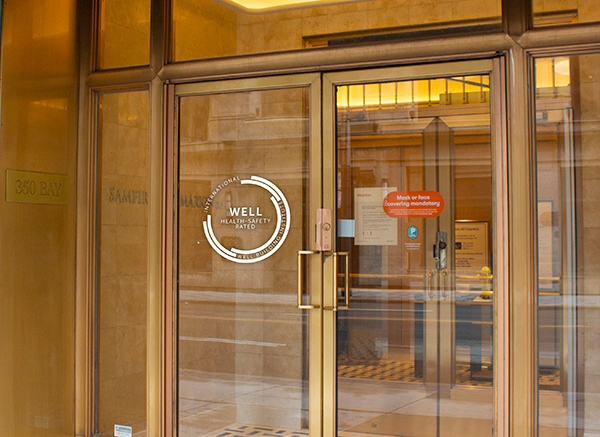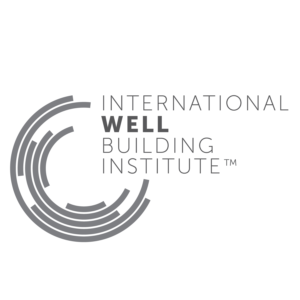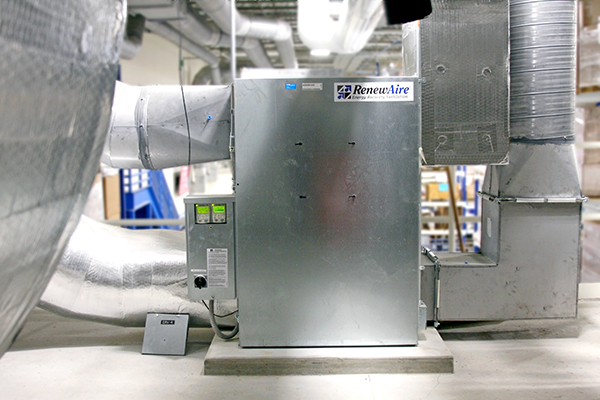
HVAC & Plumbing
Creating Healthy Buildings
Upgrading commercial HVAC systems with energy recovery ventilation (ERV) and dedicated outdoor air systems (DOAS) makes outdoor air affordable.
The post Creating Healthy Buildings appeared first on HPAC Magazine.
December 6, 2023 By Doug Picklyk

Participating in the WELL Building Standard ratings system is prompting building owners to increase levels of outdoor air in commercial towers. (photo: BusinessWire)
It’s well-known among mechanical engineers that outdoor air can mitigate airborne contaminants, but introducing unconditioned air is energy intensive. Therefore, how much outdoor air is enough to mitigate an indoor air quality (IAQ) situation such as a pandemic, or offset daily airborne CO2 or volatile organic compounds (VOC) without raising operating costs?
Many organizations are studying this unknown, and the WELL Building Institute, a fairly new building certification geared toward comprehensive occupant health, safety, and well-being, might suggest helpful strategies.
 The WELL Health Safety Seal is an emblem a building displays that confirms it has achieved the WELL Building Standard (WELL) rating. The seal and the standard are programs created by the International WELL Building Institute (IWBI) which was formed in 2013 as a public benefit corporation that works to advance a global culture of health through better buildings.
The WELL Health Safety Seal is an emblem a building displays that confirms it has achieved the WELL Building Standard (WELL) rating. The seal and the standard are programs created by the International WELL Building Institute (IWBI) which was formed in 2013 as a public benefit corporation that works to advance a global culture of health through better buildings.
Obviously, IAQ via outdoor air induction is a significant factor in a building performance standard, such as WELL, which has racked up 11,173 certified and rated projects, plus 18,588 enrolled projects for a total of 29,761 buildings with 2.72 billion sq. ft. in nearly 100 countries.
Canada has been an active WELL country boasting dozens of buildings totaling millions of square feet that are WELL certified, such as: Oxford Properties’ 277,000-sq. ft. MNP Tower in Vancouver and 250,000- sq. ft. EY Tower in Toronto; Royal Bank of Canada lists several properties totaling hundreds of thousands of sq. ft; and in 2021 Dream Office Management Corp. became the largest commercial portfolio in Canada to achieve WELL health safety rating.
Reducing CO2 Levels
Buildings earn WELL points in a variety of building categories that are applied toward gold, silver, or platinum certifications. Under the Enhanced Ventilation category applicants earn one or two points by increasing outdoor air by 30% and 60% over ASHRAE 62.1-2010 recommendations.
CO2 reduction is also emphasized in WELL and awarded points (under the Implement Demand-Controlled Ventilation category). Studies reveal that human cognitive function, productivity, and other factors are adversely affected by high concentrations of CO2 levels.
It’s not unusual for CO2 levels to rise up to 3,000-ppm in occupied spaces. The U.S. National Institute of Health (NIH) and ASHRAE both recommend CO2 levels below 1,000-ppm.
Consequently, WELL awards one, two or three points for reducing CO2 levels to 900, 750 and 600-ppm, respectively.
Incidentally, outdoor CO2 levels are approximately 425-ppm, therefore diluting indoor air with outdoor air can significantly reduce indoor CO2 levels.
This is comparable to Leadership in Energy and Environmental Design (LEED), however WELL certification must be validated annually by outside evaluators in order to maintain its health and safety status.
WELL’s Enhanced Ventilation reference surpasses ASHRAE Standard 62 minimum recommendations and could be a criterion for minimizing CO2, VOCs and even the spread of airborne pathogens.
Virus Mitigation
While viruses are invisible and untraceable with conventional sensor equipment, CO2 is easily monitored by sensors that can activate mitigating equipment, such as building management systems (BMS), self-controlled HVAC systems, energy recovery ventilators (ERVs) and dedicated outdoor air systems (DOAS).
If there’s potential for airborne viruses in occupied spaces, whether it’s a coronavirus pandemic or just influenza and the common cold, diluting CO2 to recommended levels is a good substitute in a scenario where there are few alternatives. The potential for high viral loads is greatly reduced if CO2 levels are also reduced through outdoor air dilution.
Public Health Ontario echoes this sentiment in its “Heating, Ventilation and Air Conditioning (HVAC) Systems in Buildings and Covid-19” document. The document specifically states, “high indoor CO2 levels can potentially identify spaces with poor ventilation rates,” but it also cautions that “CO2 is not an indicator of airborne pathogen transmission risk.”
ASHRAE has been moving toward a similar goal of increasing outdoor air. Last July it released its new Standard 241 “Control of Infectious Aerosols.” Building owners and operators can effectively reduce exposure to various pathogens, including the SARS-COV-2 virus responsible for COVID-19, as well as influenza viruses and other disease-causing agents that inflict significant personal and economic damage each year.
The standard encompasses a wide range of requirements covering air system design, installation, operation, and maintenance.
Adding Outdoor Air without Raising Energy Costs
Conventional HVAC systems are sized and designed to provide desired cooling and heating set points when less than 25% of outdoor air–as per compliance with ASHRAE Standard 62.1 “Ventilation for Acceptable Indoor Air Quality”–is mixed with recirculated air.
Doubling or tripling outdoor air will certainly surpass ASHRAE 62.1 IAQ compliances but will fall well short of complying with the global energy performance benchmark ASHRAE Standard 90.1-2019 “Energy Standard for Buildings Except Low-Rise Residential Buildings.”
When providing building owners with the flexibility of boosting outdoor air when needed, engineers add ERV equipment to both new construction and retrofit designs.
Generally, ERVs extract heat from the exhaust air and transfer it to the supply air in winter operation. In summer, they temper the incoming hot and humid outdoor air.
This handles both latent and sensible loads and allows more outdoor air without overdriving the HVAC units’ cooling or heating capabilities.

ERVs can be added to existing air handling units (AHUs) and any building with a conventional RTU can be converted to 100% outdoor air. (photo: Renewaire)
ERVs can be applied as supplemental outdoor air units to existing AHUs, both separately or connected to the AHU itself.
Depending on the size, configuration, and number of ERVs, any building with a conventional RTU can be converted to 100% outdoor air.
When specifying energy recovery equipment, it’s very important to consider the maintenance the end-user will be required to provide for the unit. While energy wheels have many moving parts i.e., rotor, wheel, belts or gears, etc., static plate enthalpy cores do not.
In terms of cross contamination, static plate enthalpy cores keep air streams separate, according to AHRI Standard 1060 “Performance Rating of Air-to-Air Exchangers for Energy Recovery Ventilation Equipment,” which is used to certify equipment.
Static plate enthalpy cores offer near-zero percent cross-contamination when operating with a properly balanced airflow.
Instead of the energy wheel strategy of rotating through the supply and return airstreams with the same media, static plate technology completely separates the return air from the supply air during the energy exchange process.
Many models have a leakage rate of 0.1%. The Federation of European Heating, Ventilation and Air Conditioning Associations (REHVA) backs this up with a recent position paper that stated “virus particle transmission via heat recovery devices is thought not to be an issue when a HVAC system is equipped with a twin coil unit or another heat recovery device” for separating return and supply side air stream.
Raising standards not costs
The trend in IAQ specification today, especially in the wake of COVID-19, is to introduce more than the minimum standard of outdoor air.
Healthier IAQ levels with less airborne contaminants is a positive result for occupants, but only if the additional outdoor air doesn’t cost the building owner an exorbitant operating cost. <>
Nick Agopian is vice president of sales and marketing at RenewAire. A 39-year veteran of the HVAC industry, Agopian is a member of ASHRAE TC 2.3 “Gaseous Air Contaminants and Gas Contaminant Removal Equipment” and ASHRAE SPC 62.1 “Ventilation for Acceptable Indoor Air Quality” committees. Agopian can be reached by email at nagopian@renewaire.com.
The post Creating Healthy Buildings appeared first on HPAC Magazine.
Print this page